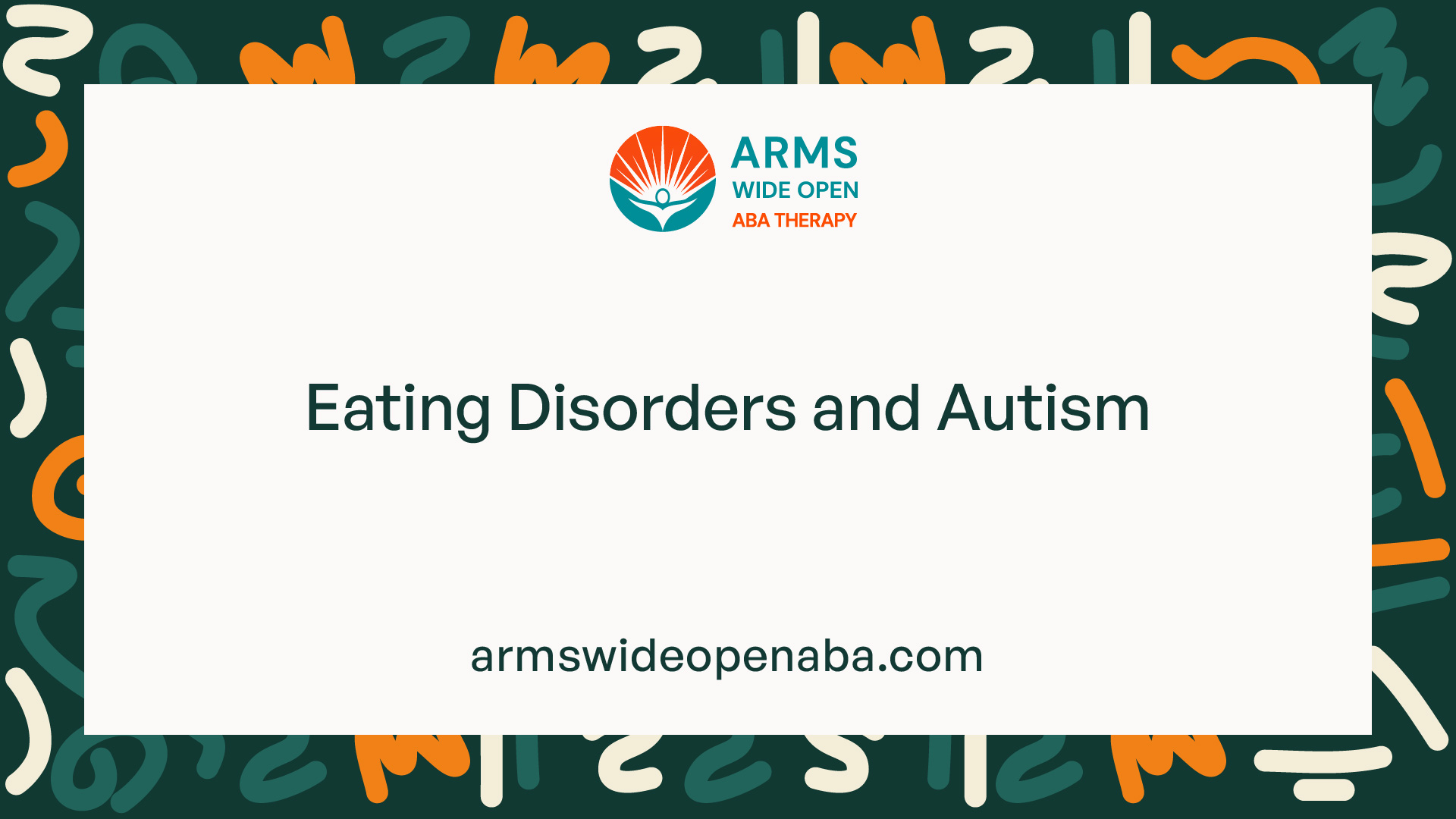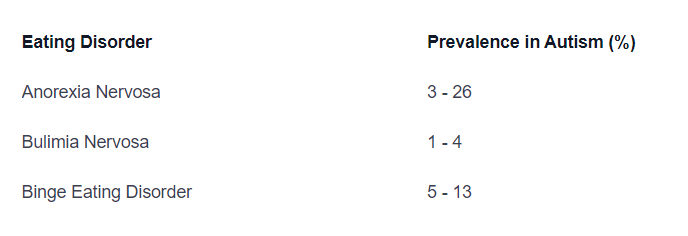Eating Disorders and Autism
Unveiling the connection between eating disorders and autism. Explore the shared characteristics and treatment considerations.

Understanding Eating Disorders and Autism
To fully comprehend the intersection between eating disorders and autism, it is crucial to have a comprehensive understanding of both eating disorders and autism individually. This section will provide an introduction to eating disorders and autism, followed by an exploration of how these two conditions intersect.

Introduction to Eating Disorders
Eating disorders are complex mental health conditions that are characterized by disturbed eating behaviors, distorted body image, and a preoccupation with weight and shape. They can manifest in various forms, including anorexia nervosa, bulimia nervosa, and binge eating disorder.
Eating disorders affect individuals of all genders, ages, and backgrounds. They can have severe physical, emotional, and social consequences, and may even be life-threatening if left untreated. Understanding the underlying factors and risk factors associated with eating disorders is crucial in identifying and addressing these conditions.
Introduction to Autism
Autism, or Autism Spectrum Disorder (ASD), is a neurodevelopmental disorder that affects social interaction, communication, and behavior. Individuals with autism may experience challenges in social interactions, repetitive behaviors, and difficulty with verbal and nonverbal communication.
Autism is a spectrum disorder, meaning that it encompasses a wide range of abilities and challenges. It affects individuals differently, with some individuals requiring significant support, while others may have higher levels of functioning.
Recognizing the Intersection
The intersection between eating disorders and autism has gained attention in recent years. Research has shown that individuals with autism are at a higher risk of developing eating disorders compared to the general population. This intersection poses unique challenges for individuals and clinicians alike.
Understanding the overlap between these two conditions can help in identifying and providing appropriate support and treatment for individuals who may be experiencing both autism and an eating disorder. Recognizing the intersection involves considering how the characteristics and challenges of autism can influence the development, presentation, and treatment of eating disorders.
By acknowledging the intersection between eating disorders and autism, healthcare professionals, caregivers, and individuals themselves can gain insights into the unique needs and experiences of those who may be affected by both conditions. This understanding is crucial in facilitating early intervention, tailored treatment approaches, and improved outcomes for individuals with this complex dual diagnosis.
Prevalence and Risk Factors
Understanding the co-occurrence of eating disorders and autism requires examining their prevalence and shared risk factors. Let's explore the prevalence of eating disorders in individuals with autism and the common risk factors associated with their intersection.
Co-Occurrence of Eating Disorders and Autism
Research has shown a higher prevalence of eating disorders among individuals with autism compared to the general population. While the exact numbers vary across studies, it is estimated that individuals with autism are at an increased risk of developing eating disorders, including anorexia nervosa, bulimia nervosa, and binge eating disorder.

It is important to note that these prevalence rates may be underestimated due to diagnostic challenges and the potential overlap of symptoms between eating disorders and autism.
Common Risk Factors
Several risk factors contribute to the co-occurrence of eating disorders and autism. While not everyone with autism will develop an eating disorder, certain factors increase the vulnerability. These common risk factors include:
- Sensory Sensitivities: Many individuals with autism experience sensory processing issues, including sensitivities to certain textures, tastes, or smells. These sensory difficulties may contribute to restricted eating patterns or food avoidance.
- Rigid Thinking and Obsessive Behaviors: Individuals with autism often exhibit rigid thinking patterns and engage in repetitive behaviors. These characteristics can manifest in the form of rigid eating habits, strict food rituals, or obsessive thoughts related to body image and weight.
- Difficulties with Social Interactions: Autism is characterized by social and communication difficulties. The challenges in understanding social cues, peer pressure, and societal norms may contribute to increased vulnerability to body image issues and disordered eating behaviors.
- Anxiety and Depression: Both autism and eating disorders are associated with higher rates of anxiety and depression. The presence of these mental health conditions can further increase the risk of developing an eating disorder in individuals with autism.
- Genetic and Biological Factors: Genetic and biological factors may play a role in the co-occurrence of eating disorders and autism. Research suggests that certain genes and neurobiological processes may influence susceptibility to both conditions, although further studies are needed to fully understand these connections.
By recognizing the prevalence rates and shared risk factors between eating disorders and autism, healthcare professionals can better identify and support individuals who may be at an increased risk. Early intervention and a multidisciplinary approach that addresses the unique challenges of these co-occurring conditions are essential in providing effective treatment and support.
Shared Characteristics and Overlaps
When examining the intersection between eating disorders and autism, it becomes evident that there are shared characteristics and overlaps between these two conditions. Individuals with both autism and eating disorders may experience challenges in various areas, including sensory processing, executive functioning, and social communication.
Sensory Processing Issues
Sensory processing issues are common in both autism and eating disorders. Many individuals with autism have sensory sensitivities or difficulties in processing sensory information. This can manifest as hypersensitivity or hyposensitivity to certain sensory inputs, such as taste, texture, or smell. Similarly, individuals with eating disorders may struggle with sensory aspects of food, leading to aversions, preferences, or restrictive eating patterns.
Understanding and addressing sensory processing issues is crucial in the treatment of both conditions. Sensory-based interventions, such as sensory integration therapy or exposure therapy, may be beneficial in helping individuals with both autism and eating disorders develop a healthier relationship with food and their sensory environment.
Executive Functioning Challenges
Executive functioning refers to a set of cognitive processes responsible for planning, organizing, and regulating behavior. Both autism and eating disorders can involve difficulties in executive functioning. Individuals with autism may struggle with planning and organizing meals, adhering to routines, or managing impulsivity. Similarly, individuals with eating disorders may exhibit challenges in decision-making, impulse control, and cognitive flexibility regarding food and eating behaviors.
Addressing executive functioning challenges requires a multifaceted approach. Strategies such as visual supports, structured routines, and cognitive-behavioral therapy can help individuals with both autism and eating disorders improve their executive functioning skills and develop healthier eating habits.
Social and Communication Difficulties
Social and communication difficulties are core features of autism spectrum disorder, and these challenges can also impact individuals with eating disorders. Both conditions may involve difficulties in social interactions, understanding social cues, and expressing emotions. Additionally, individuals with both autism and eating disorders may experience challenges in verbal and nonverbal communication, which can affect their ability to seek help or express their needs.
Supporting individuals with both autism and eating disorders requires a comprehensive approach that addresses social and communication difficulties. Social skills training, speech therapy, and counseling can help individuals develop effective communication strategies, improve social interactions, and foster a sense of belonging and support.
Understanding the shared characteristics and overlaps between eating disorders and autism is crucial in providing appropriate diagnosis, treatment, and support for individuals affected by both conditions. By addressing sensory processing issues, executive functioning challenges, and social communication difficulties, professionals can create tailored interventions that promote overall well-being and better outcomes for these individuals.
Impact on Diagnosis and Treatment
When it comes to individuals with both eating disorders and autism, there are unique challenges that impact the process of diagnosis and treatment. In this section, we will explore the diagnostic challenges, treatment considerations, and the importance of a multidisciplinary approach.
Diagnostic Challenges
Diagnosing eating disorders and autism in individuals who have both conditions can be complex. The symptoms and behaviors associated with these conditions can overlap, making it difficult to differentiate between the two. Additionally, individuals with autism may have difficulties expressing their thoughts and emotions, further complicating the diagnostic process.
To accurately diagnose eating disorders and autism in these individuals, it is important for healthcare professionals to have a comprehensive understanding of both conditions. This may involve conducting thorough assessments, gathering information from multiple sources, and considering the individual's developmental history.
Treatment Considerations
Treating individuals with both eating disorders and autism requires a tailored approach that addresses the unique needs and challenges associated with both conditions. It is important to consider the specific symptoms, behaviors, and underlying factors that contribute to the individual's difficulties.
Treatment for eating disorders and autism may involve a combination of therapies, including cognitive-behavioral therapy (CBT), dietary counseling, and occupational therapy. The focus is not only on addressing the eating disorder behaviors but also on developing strategies to manage the sensory sensitivities, social difficulties, and executive functioning challenges that are characteristic of autism.
In some cases, medication may be prescribed to address co-occurring symptoms such as anxiety or depression. However, it is essential for healthcare professionals to carefully consider the potential benefits and risks of medication, taking into account the individual's unique needs and circumstances.
Importance of a Multidisciplinary Approach
Given the complexity of treating individuals with both eating disorders and autism, a multidisciplinary approach is crucial. This involves collaboration among healthcare professionals from various disciplines, such as psychiatry, psychology, nutrition, and occupational therapy.
A multidisciplinary team can provide a comprehensive assessment, develop an individualized treatment plan, and monitor progress effectively. Each member of the team brings their expertise and perspective, contributing to a holistic approach that addresses the diverse needs of the individual.
By combining the knowledge and skills of professionals from different disciplines, individuals with both eating disorders and autism can receive the specialized care they require. This collaborative approach enhances the effectiveness of treatment and improves outcomes for these individuals.
In summary, the impact of having both eating disorders and autism on diagnosis and treatment is significant. Diagnostic challenges require a comprehensive understanding of both conditions, while treatment considerations involve tailored approaches that address the unique needs of the individual. The importance of a multidisciplinary approach cannot be overstated, as it ensures comprehensive care and improved outcomes for individuals with both eating disorders and autism.
Support and Resources
Individuals who are affected by the intersection of eating disorders and autism may require specialized support and resources to address their unique needs. Seeking professional help, accessing supportive interventions, and utilizing advocacy and community resources can all play a crucial role in the journey towards recovery and well-being.
Seeking Professional Help
When dealing with the complexities of eating disorders and autism, it is essential to seek professional help from experts who have experience in both areas. The following professionals can provide valuable guidance and support:
Professionals
Psychologists
Psychiatrists
Registered Dietitians
Therapists specializing in eating disorders and autism
Medical doctors
These professionals can conduct comprehensive assessments, provide accurate diagnoses, and develop personalized treatment plans to address the specific challenges faced by individuals with eating disorders and autism.
Supportive Interventions
In addition to professional help, there are various supportive interventions that can complement the treatment process. These interventions aim to address the unique needs of individuals with eating disorders and autism and can include:
- Social skills training: This intervention can help individuals develop and improve their social interactions, communication skills, and understanding of social cues.
- Sensory strategies: Given the sensory processing issues commonly experienced by individuals with autism, incorporating sensory strategies into treatment can be beneficial. These may include sensory integration therapy, relaxation techniques, or the use of sensory tools.
- Cognitive-behavioral therapy (CBT): CBT can be a valuable approach in the treatment of eating disorders and autism. It can help individuals identify and challenge distorted thoughts and beliefs related to food, body image, and social interactions.
- Support groups: Joining support groups specifically tailored for individuals with eating disorders and autism can provide a sense of community, validation, and understanding. These groups offer a safe space for individuals to share experiences, receive support, and learn from others facing similar challenges.
Advocacy and Community Resources
Advocacy organizations and community resources can serve as valuable sources of information, support, and connection for individuals with eating disorders and autism and their families. These resources can provide educational materials, online forums, helplines, and referrals to specialized services. Some organizations also offer workshops, webinars, and conferences to increase awareness and understanding of the intersection between eating disorders and autism.
It is important to remember that every individual is unique, and the availability of resources may vary depending on location. Researching local organizations and support networks can help individuals and families connect with relevant resources and gain access to the support they need.
By seeking professional help, utilizing supportive interventions, and tapping into advocacy and community resources, individuals affected by the intersection of eating disorders and autism can find the support and guidance necessary for their journey towards improved well-being.
Similar articles
We’re here to help you

Our team is here to assist you in this process. Contact us for any assistance.
it’s easy to apply
We Accept Most Insurances
Our in-network insurance partnerships make ABA therapy more accessible to families throughout our service areas.







Our Insurance Process
We'll request your insurance details to help us verify your plan's coverage for ABA therapy. Once we've received this information, we'll walk you through your benefits, including copayments, deductibles and out-of-pocket maximums, so you know what to expect in advance.
Our team will then handle the preauthorization and all the necessary paperwork.
.svg)





















.jpeg)


































.jpeg)




.jpeg)







.jpeg)











.jpeg)
















